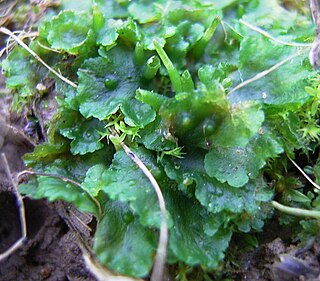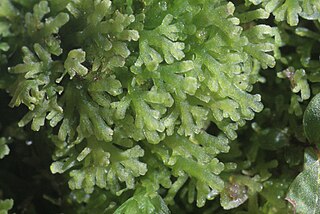
The Marchantiophyta are a division of non-vascular land plants commonly referred to as hepatics or liverworts. Like mosses and hornworts, they have a gametophyte-dominant life cycle, in which cells of the plant carry only a single set of genetic information.

Hornworts are a group of bryophytes constituting the division Anthocerotophyta. The common name refers to the elongated horn-like structure, which is the sporophyte. As in mosses and liverworts, the flattened, green plant body of a hornwort is the gametophyte plant.

Lunularia cruciata, the crescent-cup liverwort, is a liverwort of the order Marchantiales, and the only species in the genus Lunularia and family Lunulariaceae. The name, from Latin luna, moon, refers to the moon-shaped gemmacups.

Metzgeriales is an order of liverworts. The group is sometimes called the simple thalloid liverworts: "thalloid" because the members lack structures resembling stems or leaves, and "simple" because their tissues are thin and relatively undifferentiated. All species in the order have a small gametophyte stage and a smaller, relatively short-lived, spore-bearing stage. Although these plants are almost entirely restricted to regions with high humidity or readily available moisture, the group as a whole is widely distributed, and occurs on every continent except Antarctica.

Cavicularia densa is the only species in the liverwort genus Cavicularia. The species was first described in 1897 by Franz Stephani, and is endemic to Japan, where it grows on fine moist soil.

Lepidozia is a genus of liverwort in family Lepidoziaceae. It was first proposed by Dumortier in 1835.
Perssoniella vitreocincta is the only species of liverwort in the genus Perssoniella and family Perssoniellaceae. It is endemic to New Caledonia. Its natural habitat is subtropical or tropical dry forests.
Phycolepidozia exigua is the only species of liverwort in the genus Phycolepidozia and family Phycolepidoziaceae. It is endemic to Dominica, where it is critically endangered. Its natural habitat is subtropical or tropical moist lowland forests.

Haplomitriopsida is a newly recognized class of liverworts comprising fifteen species in three genera. Recent cladistic analyses of nuclear, mitochondrial, and plastid gene sequences place this monophyletic group as the basal sister group to all other liverworts. The group thus provides a unique insight into the early evolution of liverworts in particular and of land plants in general.

Blasiales is an order of liverworts with a single living family and two species. The order has traditionally been classified among the Metzgeriales, but molecular cladistics suggests a placement at the base of the Marchantiopsida.
Treubiites kidstonii is a fossil species of liverworts in the family Treubiitaceae. The only known fossils come from Late Carboniferous deposits of Shropshire, England.
Cryptothallus is a genus of liverworts in the family Aneuraceae. The plants are small, and are white to pale green as a result of lacking chlorophyll. The morphology of Cryptothallus is very similar to that of Aneura. As a result, Renzaglia, has suggested it may be considered "merely as an achlorophyllous species of Aneura." Wickett and Goffinet have argued the same position on the basis of sequences of nuclear, mitochondrial, and plastid DNA.
Allisonia cockaynei is the only species of liverwort in the genus Allisonia and family Allisoniaceae. It is endemic to New Zealand.
Makinoa crispata is the only species of liverwort in the genus Makinoa and family Makinoaceae. The genus Verdoornia was formerly included in this family, but has been transferred to the family Aneuraceae on the basis of recent cladistic analysis of genetic sequences.

Pleurozia is the only genus of liverworts in the family Pleuroziaceae, which is now classified in its own order Pleuroziales, but was previously included in a broader circumscription of the Jungermanniales. The genus includes twelve species, and as a whole is both physically distinctive and widely distributed.

Ptilidium is a genus of liverwort, and is the only genus in family Ptilidiaceae. It includes only three species: Ptilidium californicum, Ptilidium ciliare, and Ptilidium pulcherrimum. The genus is distributed throughout the arctic and subarctic, with disjunct populations in New Zealand and Tierra del Fuego. Molecular analysis suggests that the genus has few close relatives and diverged from other leafy liverworts early in their evolution.
Trichotemnoma is a genus of liverworts restricted to New Zealand and Tasmania, and contains a single species Trichotemnoma corrugatum. It is classified in order Jungermanniales and is the only member of the family Trichotemnomataceae within that order. The generic name Trichotemnona was originally published in 1964, but that publication was invalid under the ICBN.
Neotrichocoleaceae is a family of liverworts in order Jungermanniales. It is closely related to the genera Ptilidium and Herzogianthus.

Cephaloziaceae is a family of liverworts.

Fossombroniales is an order of liverworts.











